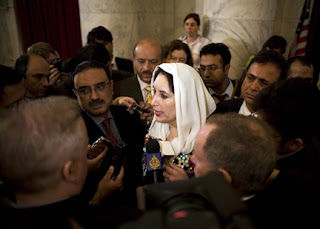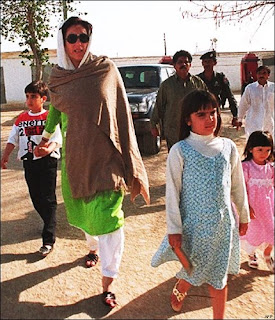Saturday, February 21, 2009
Friday, February 20, 2009
Wednesday, February 18, 2009
Bhutto Assassinated

Benazir Bhutto greets her supporters at the rally that was hit by a suicide attack.
While Bhutto appeared to have died from bullet wounds, it was not immediately clear if she was shot or if her wounds were caused by bomb shrapnel.
President Pervez Musharraf held an emergency meeting in the hours after the death, according to state media.
Police warned citizens to stay home as they expected rioting to break out in city streets in reaction to the death.
Police sources told CNN the bomber, who was riding a motorcycle, blew himself up near Bhutto's vehicle. Video Watch aftermath of the attack. »
Bhutto was rushed to Rawalpindi General Hospital -- less than two miles from the bombing scene -- where doctors pronounced her dead.
Former Pakistan government spokesman Tariq Azim Khan said while it appeared Bhutto was shot, it was unclear if the bullet wounds to her head and neck were caused by a shooting or if it was shrapnel from the bomb. Video Watch Benazir Bhutto obituary. »
Bhutto's husband issued a statement from his home in Dubai saying, "All I can say is we're devastated, it's a total shock."
The number of wounded was not immediately known. However, video of the scene showed ambulances lined up to take many to hospitals.
The attack came just hours after four supporters of former Pakistan Prime Minister Nawaz Sharif died when members of another political party opened fire on them at a rally near the Islamabad airport Thursday, Pakistan police said.
Several other members of Sharif's party were wounded, police said.
Bhutto, who led Paksitan from 1988 to 1990 and was the first female prime minister of any Islamic nation, was participating in the parliamentary election set for January 8, hoping for a third term.
A terror attack targeting her motorcade in Karachi killed 136 people on the day she returned to Pakistan after eight years of self-imposed exile. View timeline. »
CNN's Mohsin Naqvi, who was at the scene of both bombings, said Thursday's blast was not as powerful as that October attack.
Thursday's attacks come less than two weeks after Pakistan President Pervez Musharraf lifted an emergency declaration he said was necessary to secure his country from terrorists.
Bhutto had been critical of what she believed was a lack of effort by Musharraf's government to protect her.
Tuesday, February 17, 2009
Benazir Bhutto Becomes Prime Minister [1993]
Benazir Bhutto returned to power for the second time in 1993 after the resignation of both President Ghulam Ishaq Khan and Prime Minister Nawaz Sharif on July 18, 1993. The resignation led to the announcement of fresh elections for the National and Provincial Assemblies. The elections were held on October 6 and 9, 1993, respectively.
The elections were boycotted by the M. Q. M. No party emerged with an absolute majority in the elections. As a result the P. P. P. formed the new government with the help of alliances. Benazir Bhutto took oath as Prime Minister on October 19, 1993. The Presidential election was held on November 13. Farooq Ahmad Khan Leghari, the P. P. P. candidate, won by 274 to 168 votes against the then acting President Wasim Sajjad.
During her second tenure, Benazir again faced trouble from the opposition. In the autumn of 1994, Nawaz Sharif led a "train march" from Karachi to Peshawar. This was followed by general strike on September 20. Two weeks later Nawaz Sharif called a "wheel jam" strike on October 11.

Benazir Bhutto inaugurating supply of natural gas to a town in 1995
Benazir Bhutto's brother, Mir Murtaza Bhutto, was assassinated under mysterious circumstances in a police ambush on September 20, 1996. The high-profile killing of her brother in her tenure damaged her political career.
Things were not going well between the President and Benazir's Government. Differences soon appeared and the Government felt that there was interference in the political matters of the Government by the President. President Farooq Leghari dismissed Benazir Bhutto's Government on charges of corruption and mismanagement on November 5, 1996, under the Article 58(2) b of the Eighth Amendment.
Ghulam Ishaq Khan becomes President [1988-93]
In 1988, President Zia-ul-Haq dissolved the Junejo Government and announced that fresh elections would be held in November 1988. But on August 17, 1988, he was killed in a C-130 plane crash in Bhawalpur, along with five senior Generals and the American Ambassador. The cause of the crash has never been ascertained and still remains a riddle.
After the death of General Zia, Ghulam Ishaq Khan, Chairman of the Senate, took over as acting President. Elections for the National and Provincial Assemblies were held on November 16 and 19, 1988, respectively. The Revival of the Constitutional Order had amended the Constitution, which empowered the President to appoint, at his discretion, any member of the National Assembly as Prime Minister. Ghulam Ishaq Khan appointed Benazir Bhutto as Prime Minister of Pakistan on the condition that she would offer full support to him in the forthcoming presidential elections.
According to the deal between Ghulam Ishaq Khan and Benazir Bhutto, Pakistan Peoples Party voted for Ghulam Ishaq Khan. Ghulam Ishaq Khan was also the consensus candidate of Islami Jamuhri Ittehad. Four candidates took part in the elections, with Ghulam Ishaq Khan winning and securing the highest 608 votes. Constitutional Amendments made by the R. C. O. and the Eighth Amendment, that had given the President a great deal of power, inevitably led the President and the Prime Minister into conflict. The conflict between the President and the Prime Minister arose in two areas; the appointment of the Military Chiefs and the Superior Court Judges.
The conflict between the President and the Prime Minister had its drop scene on August 6, 1990, when the President dissolved the National Assembly and Benazir Bhutto was dismissed from power. The dissolution of the National Assembly was soon followed by the dissolution of the Provincial Assemblies. Fresh elections were scheduled on October 24, 1990. President Ghulam Ishaq Khan appointed Ghulam Mustafa Jatoi as the caretaker Prime Minister.
 President Ghulam Ishaq Khan speaking at the banquet hosted in his honor by the
President Ghulam Ishaq Khan speaking at the banquet hosted in his honor by the
Iranian President in Tehran, 1991
Elections for the National and Provincial Assemblies were held on October 24 and 27, 1990, respectively. Mian Muhammad Nawaz Sharif was elected as Prime Minister on November 1, 1990. Nawaz Sharif's Government remained in power till April 19, 1993. President Ghulam Ishaq Khan again dissolved the National Assembly, exercising his power once again through the Eighth Amendment, and appointed Mir Balakh Sher Khan Mazari as the caretaker Prime Minister. General Elections were scheduled to be held on July 14, 1993, but were canceled when the Supreme Court quashed the Presidential Order and reinstated Nawaz Sharif as the Prime Minister.
Differences between Nawaz Sharif and Ghulam Ishaq Khan arose once again. This time they deepened to such an extent that they led to the resignation of both President Ghulam Ishaq Khan and Prime Minister Nawaz Sharif on July 18, 1993. The National and Provincial Assemblies were also dissolved. Moin Qureshi was appointed as the caretaker Prime Minister, and Ghulam Ishaq Khan was appointed the caretaker President. Fresh elections for the National and Provincial Assemblies were held. Benazir Bhutto returned to power for the second time and Farooq Ahmad Khan Leghari was elected as the new President of Pakistan.
This brought to an end the presidency of Ghulam Ishaq Khan, which brought about the dismissal of two elected governments. It followed the unhealthy tradition of removing elected governments through the use of the controversial Eighth Amendment. The next President followed the same tradition and created continuous instability in the country.
Benazir Bhutto Becomes Prime Minister (1988)
 Benazir Bhutto taking oath as the first woman Prime Minister of Pakistan
Benazir Bhutto taking oath as the first woman Prime Minister of Pakistan The fourth S. A. A. R. C. Summit Conference was hosted by Pakistan in December 1988
The fourth S. A. A. R. C. Summit Conference was hosted by Pakistan in December 1988
Soon after taking oath, Prime Minister Benazir Bhutto announced that the ban on Student Unions and Trade Unions would be lifted. The P. P. P. Government hosted the fourth S. A. A. R. C. Summit Conference in December 1988. As a result of the Conference, Pakistan and India finalized three peace agreements.
But soon, Benazir's Government started facing problems on the political front. A. N. P. deserted the Pakistan People Party and on November 1, 1989, a no-confidence motion was moved against the Prime Minister by the opposition. Benazir was barely able to pull through with 12 votes to her advantage. M. Q. M., which had formed an alliance with the P. P. P. also broke away and started creating trouble in Sindh.
 Pakistani Prime Minister Benazir Bhutto with Indian Prime Minister Rajiv Gandhi
Pakistani Prime Minister Benazir Bhutto with Indian Prime Minister Rajiv Gandhi
Serious conceptual differences arose between the P. P. P. Government and the Establishment. Less than two years later, on August 6, 1990, her Government was accused of corruption and dismissed by the President, Ghulam Ishaq Khan, who exercised his power through the controversial Eighth Amendment of the Constitution.















































